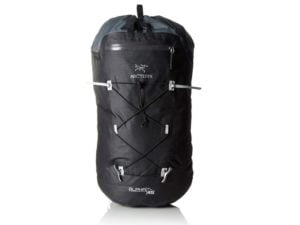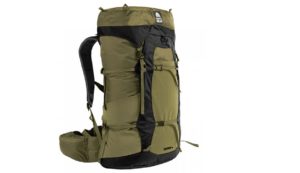When you are checking out backpacks, trying to find what size backpack you should use for your thru-hike you want to look into the following traits for your personal best fit. Each will depend on your available funds and the needs of your other gear and weight of the items contained within.
What size backpack for a thru-hike? The best backpack size for a thru-hiker will be 45-60 Liters in internal capacity along with being able to hold 25-40 pounds of gear, water, and food. There are ultralight options available but this relies on your gear being small, compact, and very lightweight along with a greater monetary expenditure.
Now we will take a look at each type of backpack and we will approach it more from the weight and carrying capacity it is capable sof carrying. This will then help you in making a choice as to which would fit your needs the best to give you a better ability to finish your thru-hike.
Ultralight Backpacks

These backpacks are the cream of the crop, super lightweight but also much lower durability. These are the ones made of Dyneema and are many times handcrafted and created at the time of order. The most popular vendors are ZPacks, Hyperlight Mountain Gear, and Katabatic Gear.
The normal weight of an “ultralight” backpack by itself ranges from 14-15oz to 2lbs. Most of the Dyneema packs will be a sub-one pound and typically in the 14-15oz or fewer than even that!
Ultralight Benefits
The benefits to a thru-hike are that they are able to be incredibly light and hold a large volume at a decent weight. These backpacks are typically frameless which also helps them keep the super low weight, Dyneema, which is used in most of these packs is already near waterproof which means keeping your gear dry without needing additional covers.
Ultralight Drawbacks
Dyneema is very fragile and if not treated well will break down over time, many times less than a thru-hike if you are always just chucking it to the ground. This means remembering to set it down nicely when you stop and not to use it as a seat or for miscellaneous uses.
The other large drawback is that these backpacks frequently are VERY cost-prohibitive to most hikers. Many of them will average $300-$600 for the backpack alone without any addons purchased.
Lightweight Backpacks
This is where the Sil-Nylons start to take over, known for the fabric type and the waterproof nature, these packs are available for a little better price than their ultralight cousins above. These packs are much more able to withstand the rigorous adventures of thru-hiking without many of the issues the ultralight backpack purchaser will face.
Lightweight backpacks typically by themselves weigh in at a range of 2-3.5 lbs when empty.
Lightweight Benefits
These backpacks start to have lots of extras included with them during purchase. There is less of a reliance on add-ons during purchase, that being said, these are mass-produced and typically can just be picked up off a store shelf.
Sil-Nylon is a strong benefit in this category of a backpack as it is waterproof and much stronger than Dyneema. In these, you get a backpack that while heavier is much more durable and typically 1/2 as expensive as the ultralightweight backpack.
Lightweight Drawbacks
Most of the drawbacks in this level of a backpack are the lack of being tailored to you, they are not custom fit to your measurements meaning you need to take time to adjust it properly.
They also start to become heavy fast as this range allows for super large 60-70 liter backpacks in some cases. Thru-hikers will want to avoid these very high liter backpacks as you don’t need this extra space nor the weight it adds to your backpack.
Standard Backpacks

These start to use more traditional fabrics which drops the price a lot in comparison to the two earlier and lighter versions. These are the backpacks that many people purchase and plan to use for years of day and week hikes.
Standard backpacks are going to range from 3.5-6lbs in most brands.
Standard Benefits
These continue the movement into a normal price range from $80-250 for a good durable, quality made backpack.
Standard Drawbacks
Material is less waterproof and more often than not will allow water direct access to the stored items inside. This requires purchasing dry bags for the inside and added a pack cover outside to ensure rain doesn’t penetrate the backpack.
Heavy Duty Backpacks
These are the heavy, military-style rugged packs built to survive just about anything the world should throw at them. The heavy-duty pack is the old-style duffels the military would carry, they are what you find typically in a military surplus store.
Heavy Duty Benefits
Incredibly rugged and built from very durable fabrics, this means they last through years and years of abuse without falling apart.
Heavy Duty Drawbacks
Weight is the main drawback as the weight on these can be 6-15 pounds of frame and pack.
30-40 Liter
This rating in a backpack is super limited in useable storage space for a backpack. It is more suited to an ultralight backpacker approach where your gear is super lightweight and compact.
The typical weight a 30 to 40-liter pack will hold is in the range of 20-30 pounds max weight.
40-50 Liter
These are a typical mid-range size that many thru-hikers will go for as it allows for some heavier gear and more space to hold it. This also is a typical sweet spot for the cost for purchases also.
The typical weight of a 40 to 50-liter pack to hold comfortably is 30-40 pounds.
50+ Liter
These are the big packs, the ones with larger heavier gear that takes up a lot of space. These are not always heavy packs but are typically on the weightier side.
The typical weight of a 50+ liter pack is around 35+ pounds.

Best Overall Backpack For Multi Hike Use
If you are a person who can only look at a single pack which you would need to use on many of the above options what you need to do is find a pack which is light enough for the medium and longer hikes while being durable enough and able to carry weight.
This combo is not available in many packs as typically the lighter the backpack the easier to wear the materials will be. This leads you to a couple of backpacks which will fit the needs of each of the hikes above while being of good enough quality, durability, and lightweight.
Backpack Comparison Table
[amazon table=”915″]
Final Thoughts on What Size Backpack for a Thru Hike
While no backpack is a perfect fit for everyone you do want to size your backpack to the task ahead. You will be looking to carry this backpack over 2000 miles and over time it will wear on you and your body.
Also, make sure to not oversize on the liters as most will decide to add more weight and things they don’t need to “fill the pack up”. Instead, make sure you have all your gear and try to evaluate the correct size for your pack to store your needed gear.
For a thru-hiker, you want to try and focus on limiting the pack weight overall for yourself which will give you better longevity over the course of your hike. Not only saving your shoulders but saving your legs and knees from carrying the weight over time, treat your legs like gold and they will reward you handsomely.

